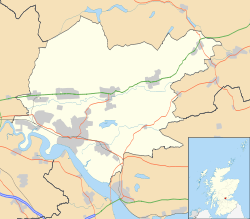Tullibody
| Tullibody | |
| Scottish Gaelic: Tulach Bòide | |
 Residential area of Tullibody with the Ochils in the background |
|
 Tullibody |
|
| Area | 3.03 sq mi (7.8 km2) |
|---|---|
| Population | 8,345 [1][2] (2008 est.) |
| – density | 2,754/sq mi (1,063/km2) |
| OS grid reference | NS859951 |
| Council area | Clackmannanshire |
| Lieutenancy area | Clackmannanshire |
| Country | Scotland |
| Sovereign state | United Kingdom |
| Post town | ALLOA |
| Postcode district | FK10 |
| Dialling code | 01259 |
| Police | Scottish |
| Fire | Scottish |
| Ambulance | Scottish |
| EU Parliament | Scotland |
| UK Parliament | Ochil and South Perthshire |
| Scottish Parliament | Clackmannanshire and Dunblane |
Coordinates: 56°08′07″N 3°50′11″W / 56.135400°N 3.836405°W
Tullibody (Scottish Gaelic: Tulach Bòide) is a town set in the Central Lowlands of Scotland. It lies north of the River Forth near to the foot of the Ochil Hills within the Forth Valley. The town is 1.8 miles (2.9 km) south-west of Alva, 1.8 miles (2.9 km) north-west of Alloa and 4.0 miles (6.4 km) east-northeast of Stirling. The town is part of the Clackmannanshire council area.
According to a 2009 estimate the population of Tullibody is approximately 8,300 residents including the area of Cambus.[1]
History
Tullibody is a former mining town, although neither that industry nor any other major employers have a presence in the town, with many of the residents now commuting to Stirling and Alloa to work. Since the late 1990s and early 2000s, there has been a rapid expansion in housebuilding in the town, with 400 new houses built on the north side of the village in the last 5 years.
It is thought that St. Serf first set up a church on the site of its present Auld Kirk in the 5th century when Christianity was brought over from Ireland. Folklore states that Kenneth MacAlpin, King of Scots, amassed his army on Baingle Brae before he fought and subdued the Picts. Certainly there was a standing stone on the main road to Stirling (near the Catholic Church) until the early 1900s when it is then reported to have been demolished to make ready for the road upgrading.
David I of Scotland was responsible for Tullibody’s claim to fame when in 1149 he granted the lands and fishing rights to Cambuskenneth Abbey and it was then that the Auld Kirk was erected, where it still stands today. In January 1560, William Kirkcaldy of Grange demolished part of Tullibody bridge to delay French troops returning to Stirling Castle. The French commander Henri Cleutin took down the roof of the Auld Kirk to repair the bridge.[3] Until the Scottish Reformation in 1560 the religion was Catholic but then became Protestant. Tullibody has been served well, being the Parish Church of the area until that time when it lost its celebrity status and Alloa took the title. The Abercrombys made The Auld Kirk their family vault.
Edward I of England, in his attempt to subdue the Scots in 1306 reportedly tried to build a castle in Tullibody, on the hill behind the Delph Pond. As it would have been of wooden construction, no one has ever found any proof.
The early people worshiped the sun and it is now known that Tullibody War Memorial stone formed part of a Druid Circle. The smaller stones were removed in the late 1700s. We know very little about these early people but other areas of Scotland have found many artifacts showing that they hunted and gathered food from the land and sea.
On Braehead Golf Course, the green-keepers found a shell midden. One of the few found on the north side of the Forth. It contained shell remains of mussels, scallops and cockles dating back to 4000 BC.
Education
The town has four primary schools – St. Bernadette's, Abercromby, Banchory and St. Serf's – with young people also attending the local high schools including Lornshill Academy, St Modan's High School, Alloa Academy and Alva Academy.
Notable people
- Lieutenant-General Sir Ralph Abercromby, KCB (sometimes spelled Abercrombie) (7 October 1734 – 28 March 1801) was a British lieutenant-general noted for his services during the Napoleonic Wars.
- Robert Dick (January 1811 – 24 December 1866), geologist and botanist was born in Tullibody.
- Malcolm Robinson, formerly of Muirside Road, Tullibody is a UFO and paranormal expert and author who has represented Scotland at UFO and Paranormal conferences, appeared on British and overseas television, and has written four books. He now lives in Hastings, East Sussex, England.
- Civil engineer Ralph Walker (1749 –– 1824) was born in Tullibody.
See also
References
- 1 2 Population Breakdown by Settlement 2009, ClacksWeb Retrieved 2011-05-29.
- ↑ Includes the area of Cambus
- ↑ Laing, David, ed., 'John Knox's 'History of the Reformation', Book 3,' The Works of John Knox, vol. 2, Bannatyne Club, Edinburgh (1848), p. 14
External links
- Tullibody Library
- Tullibody History Group & Heritage Centre
- Tullibody Community Information
- Tullibody Cambus & Glenochil community council
- Tullibody Community Football Club
- ClacksNet - Clackmannanshire's Community Network